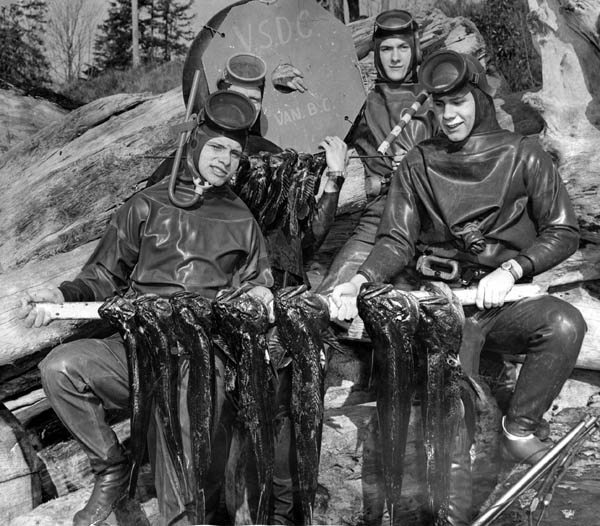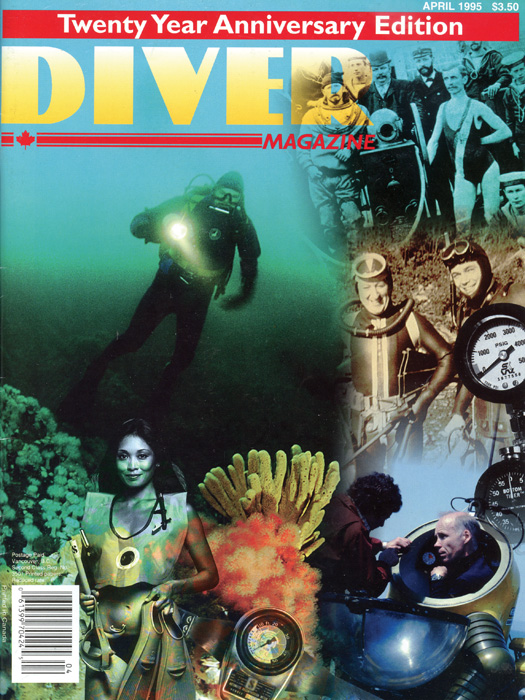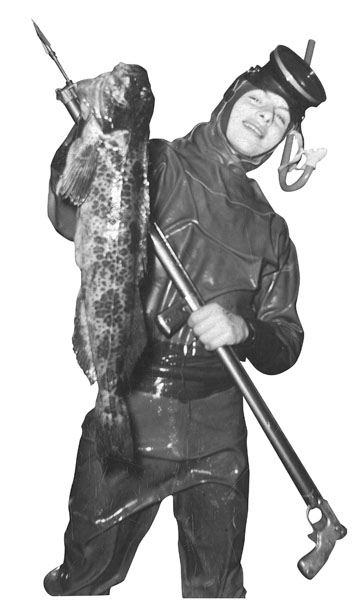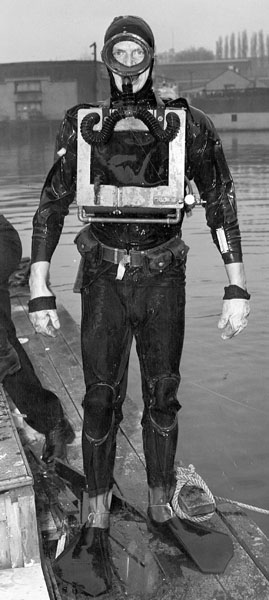From the archives: Back in the 50s – Nitrox and Rebreathers, so what’s new?
Originally Published for DIVER April 1995
By Phil Nuytten

Pat Molony, Jim Willis and Cam Porteous. Photo: Ted Willis
So there I was, right at the edge, one foot actually in the water. I kneeled down to pull on my fin and lost my balance. Just a little. My knee moved forward and down, perhaps six inches, no more. In one heartbeat, I sent an innocent clump of barnacles to their final reward and poked a hole in my dry suit. Great snapping rectums! And, wouldn’t you know it, the water was that special sparkly blue-green that says quietly and smugly, “I am very, very clear today…you are going to like this!” I crawled back up the rocky ledge on all fours – being careful not to put another hole in my suit. My mouthpiece and shut-off valve bounced over the rocks, then hung up, stretching the corrugated rubber breathing hose. The MSA rebreather wasn’t particularly heavy but it was awkward in the ‘crawl mode’ and the left shoulder strap kept slipping down off the crown of my shoulder. I got back to where I’d changed and knelt on my clothes as I dumped my duffle bag, looking for the crown royal bag that held my patching kit.
Cam Porteous shook his head in sympathy. He was standing in waist-deep water, just an arm’s length from the edge. He reached down and checked off the tied-off entry chute protruding from his chest, to make sure that the wraps of surgical tubing were secure. He pulled the face seal of his hood away from his face and bent his knees. Air rushed out of the suit with a ‘whooshing’ sound and he let the face seal snap back just as the water reached and touched his chin. He pulled his white mask down off his forehead, caught the side pieces between his thumbs and forefingers and folded it partially back on itself. He brought it up to his face and let it snap into its original shape. With almost the same movement, he tucked the corners of the mask under his face seal so that he could add air to the suit by blowing through his nose. Every movement was deft, practiced – almost an unconscious reflex. He retrieved his arbalete spear gun from between his knees and snugged the handle against his belly, just above the quick release buckle on his weight belt. The metallic blue metal glinted in the sun. He pulled the arbalete rubbers back to the first notch, paused, then back to the second machined groove in the steel arrow.
 As he launched himself forward, Cam turned his head and looked back to monitor my progress. He gave a little backward wave with his free left hand and paddled away on the surface. His snorkel ‘chuffed’ in regular rhythm and the water streaming off his black fin blades flashed in the sun.
As he launched himself forward, Cam turned his head and looked back to monitor my progress. He gave a little backward wave with his free left hand and paddled away on the surface. His snorkel ‘chuffed’ in regular rhythm and the water streaming off his black fin blades flashed in the sun.
He didn’t have far to swim. The water was deep here, just north of the white marker at Whytecliff reef. I watched Cam fan his free arm and his fins as he hyperventilated. He exhaled – held it for a few seconds to slow his heart – a long slow, filling inhalation and then he snapped his legs up in a motion that the French call a ‘coup de reins’, a stroke of the loins. Down – in a perfect duck dive, fin tips pointing to the sky as they vanished with hardly a ripple. The water was very clear. I watched him as he stroked slowly and strongly down, his arbelete held out in front of him and a string of pearly bubbles trailing from his snorkel. He paused to clear at about thirty feet and I could still see him well. His gum rubber dry suit blended with the reef, but the white mask and the heels of his bright red ‘thermal sox’ (we called them ‘fruit boots’ and wore them to protect the thin dry suit boots) were visible. Cam slowly moved his head back and forth looking for a familiar shape amid the short laminara kelp stalks. Looking for a silhouette raising up on its pectorals, or the movement of the dorsal fin coming erect as the owner prepared to flee.
After what seemed like a long time, Cam moved to a vertical position and then methodically stroked his way back to the surface. He blew his snorkel clear, took a long whistling breath, and came upright in the water. He lifted the white mask up onto his forehead, covered his nose with a cupped hand and snorted. Then he grinned.
“How is it?” I yelled. His grin expanded. A wonderful white-toothed, mouth stretching, grin of sheer teen-age joy.
He yelled back, “Phil, it just doesn’t get any better!”
That was Sunday, July 2, 1955. Forty years ago. Cam was absolutely right…It just doesn’t get any better!

The More Things Change…
Forty years. Wow! Twice as long as DIVER Magazine is old. The next thought that usually comes to mind is, “Things are sure different now.” Things? Like what? “Well, diving equipment sure has changed!”. I wonder. In many ways, the diving gear of forty years ago is more like today’s equipment than the gear of, say, twenty-five years ago. Perhaps it’s like the man that says: “The more things change, the more they remain the same.” For example, drysuits have certainly come back with a vengeance! (Albeit with some design improvements.) Twenty-five years ago, only commercial divers wore drysuits, while virtually everyone sport diver owned a ‘custom’ wet suit. Our gumrubber dry suits of the fifties were about the same as today’s ‘shell’ suits – some even had zipper entry and an external inlet valve. Most were neck, waist, or front-entry, however, and were equalized by blowing air from your mask under the face seal. (No neck seals!) How do you get it out on the ascent? Well, some suits had one-way, ‘flutter valves’ on the back of the neck or the top of the hood. Most of us eschewed such frills and depended on throwing the head back, stretching the neck like a goose, and expanding air would burst out of the two hollows of your throat. (Boy, I’d hate to have to do that, now that I look like ‘Jabba the Hutt!”)…..
In January, 1995 I gave a talk at the TEK ‘95 conference in San Francisco – an annual forum for technical divers. Then I hung around to catch the DEMA (Diving Equipment and Marketing Association) show. The hot, new hardware at the show? Rebreathers. Jeezz! I could hardly believe it! Dry suits and rebreathers, same as the fifties. Wait on, what about the other ‘new’ stuff – NITROX, for example? Nope, we knew about Nitrox – called it ‘High oxygen diving’ – mostly commercial and scientific guys used it, but the ‘relative oxygen depth’ and the ‘equivalent air depth’ table calculations were available. Masks? The ‘Pinocchio’ of the fifties was virtually identical to most masks used today. Snorkels? Gee, I waited over forty years to see the ping-pong ball snorkel reappear in a snappier format! Single hose regs? Nope. Bin there, done that! At least six models of single hose regulators were available in the fifties. Fins? By God, I don’t believe that anyone is stupid enough to suggest that a better fin was ever made than Saint Art Browne’s (for, surely, he has been canonized by now!) gum-rubber miracle, ‘Super Extra Large Duckfeet’. Spearguns? Whooops! heh, heh…think I’ll stop there.
Some of you are probably rolling your eyes and circling your forefinger by the sides of your heads – still others may be just now turning the page. Wait! Wait! Turn back. I am just about to recant! I was just being fiftyish.
The truth is, in my humblest of opinions, that there have been only a few really fundamental changes in diving equipment, but everything, absolutely everything, is easier, smarter, safer, more comfortable, more durable, more colourful, MORE BETTER! What a great time to be a diver! Cam was right when said that diving doesn’t get any better, but the equipment sure did!
And the few ‘fundamental changes’? Well, maybe ‘fundamental’ is a bit strong…I mean things that either didn’t exist before or improvements so great that they constitute a major break-through. Think about it. I f I had found a camcorder in my room, in the fifties, I would have thought that pygmy aliens had arrived to abduct my gerbil! And dive computers – Oh, my! Don’t even think about the single-orifice ‘Decompression meters’ of the fifties. They had ‘individual table tailoring’, but it was by accident, not design! Look at your wrist computer next dive and think about how lucky you are. Today’s computers combine a watch depth gauge, thermometer, maximum depth indicator, tank pressure gauge, decompression computer, pre-dive planner and post-dive recorder. That’s my idea of a major improvement!

Laying Foundations
There are also a lot of not-quite-major-but-pretty damn good products: Like all of the things made out of silicone rubber. General Electric had ‘RTV 630’ silicone rubber out in the fifties but it was available in ‘research kits – for scientists’ and cost twelve bucks per thimble-full! And BC’s…compare a Zeagle ‘techdiver’ to our war-surplus ‘Mae Wests’ or filched airline life-vests! And, yes, spearguns: If you ever had to use two hands to squeeze the trigger on an old arbalete, then you’d agree that Jay Riffe’s ‘Blue Water Hunters’ could bring tears to a glass eye! And fins: I hate to say it, Art, but Bob Evans’ ‘Force Fins’ are the first true technological advance in swim fins in decades. Force fins aren’t better or worse than Duckfeet, only much different. Nowhere near the brute power of some giant fins, including duckfeet, but more go-forward per calorie expended than anything I’ve ever used (Nope, I don’t own a chunk of the company!). Oh, oh, almost forgot ‘Aquaseal’ – liquid polyurethane – would have killed for it in the fifties. And Haagen-Das ice cream…well, you get the idea.
So, you may ask, what is the point of this article? There should be one. Be kind of foolish to take all this room and not have anything important to say. Let’s see…Baby boomers go diving? Sure, but… so what? Baby boomers diving less now but enjoying it more? No, Cam was right, the diving doesn’t get any better than it was in the fifties. Hmmm…I know! The gear is basically the same. Yeah, right, like Mother Theresa is basically the same as Madonna!
Perhaps the point is just a squint back. Maybe a small pat on the back for the guys who started the sport of diving in British Columbia. The guys like Cam, who never dreamed they were laying the foundations for an activity that would bring joy to tens of thousands. The guys like Cam, who did it because it was just so great…”Way cool!” the kids would say now. Only problem with that as a point, is that I would then be giving myself credit and that makes me a little uncomfortable, because I’m normally very modest. Why are you laughing? You cheeky devils!
Anyhow, DIVER mag is twenty years old, this year. That’s an impressive achievement. The sport of diving in B.C. will be fifty years old in 1998. Now that will be an impressive achievement that calls for a major celebration! Guess where you’ll be reading about it.
Originally Published for DIVER April 1995
Leave a Comment







